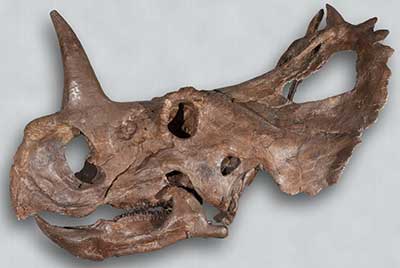Centrosaurus
(SENT-roh-saw-rus)
| Quick Facts | |
|---|---|
| Name Meaning: | Well-Horned Lizard |
| Distribution: | Canada, Alberta; Montana, USA |
| Time Period: | Late Cretaceous, 75 Ma |
| Length: | 20 ft (6 m) |
| Diet: | Herbivore |
| Habitat: | Swamps, Rivers |
| Linnaean Classification | |
| Kingdom: | Animalia |
| Phylum: | Chordata |
| Class: | Sauropsida |
| Superorder: | Dinosauria |
| Order: | Ornithischia |
| Suborder: | Marginocephalia |
| Infraorder: | Ceratopsia |
| Family: | Ceratopsidae |
| Genus: | Centrosaurus |
| Cladistic Classification | |
| |

History
The Centrosaurus was first discovered by Lawrence Lambe in 1904. The discovery was near the Red Deer River in Alberta, Canada. Later several bonebeds were found in the Dinosaur Provincial Park, also in Alberta. These bonebeds contained several skeletons from many species. Scientists have speculated that this would have been a river were many dinosaurs died in the crossing.
Description
The Centrosaurus was a stocky dinosaur with large strong muscles. While not the largest dinosaur of its family (only 20 ft long) it appears a lot like the modern Rhinoceros. It had a curved nasal horn, which often curved inward, or outward depending on the species. Its frill had two small hooks that curved forward. Its feet, like others of its kind, had four toes splayed out. Many have questioned the stance of the Centrosaurus and others of the Ceratopsidae family. Some think they walked with the legs splayed to the sides while others argue that the legs were kept under the animal.Lifestyle
Due to the fact that the Centrosaurus had places for muscle attachment on its frill, this allowed the dinosaur to have a particularly strong bite. The frill was probably used as a display or as a way of distinguishing between species. The frill was too thin to be used as a defense against predators unlike the Triceratops. This has led some to conclude that the Centrosaurus feasted on tougher vegetation. The bonebeds discovered in Alberta, Canada, suggest that the animals traveled in herds, although this may have been a group gathered to a Cretaceous hot spot like a waterhole during a drought.
ScienceViews Writer: Jason Hamilton.
Copyright © 2005-2010 Calvin & Rosanna Hamilton. All rights reserved.